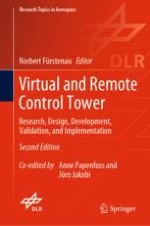2022 | OriginalPaper | Chapter
Which Minimum Video Frame Rate is Needed in a Remote Tower Optical System?
Authors : Jörn Jakobi, Maria Hagl
Published in: Virtual and Remote Control Tower
Publisher: Springer International Publishing
Activate our intelligent search to find suitable subject content or patents.
Select sections of text to find matching patents with Artificial Intelligence. powered by
Select sections of text to find additional relevant content using AI-assisted search. powered by
